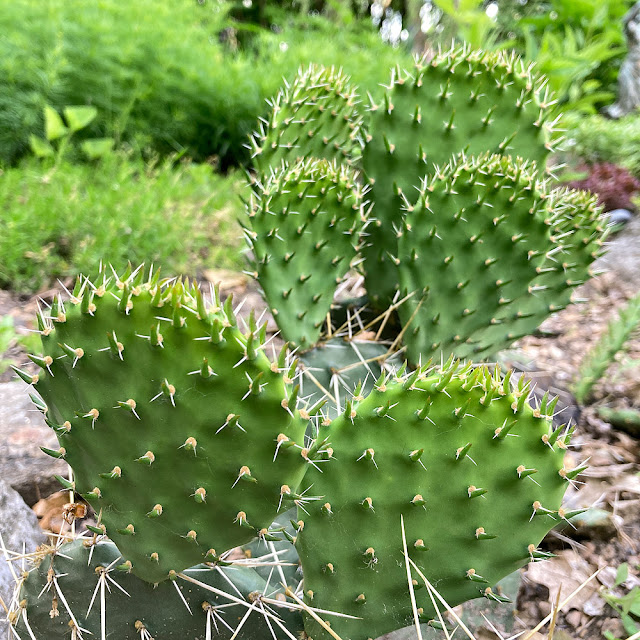Opuntia humifusa, Eastern Prickly Pear
 |
| Prickly Pear pads in our gardens |
When people think of cactus, they don't imagine them in Minnesota, they think of the desert. Yet, there are cactus in Minnesota!* Just like you and me, they live here but don't appreciate the cold, wet spells of October through November and again in March into May.
How do these plants get around that cold, moist Minnesota climate? They grow in sand, gravel, rocky outcrops, slopes, and even clay -as long as the spot can easily drain away the moisture that would otherwise rot them in the cold, wet months. Yet, this cactus also has a better trick -Prickly Pear "deflates" as winter approaches and then, in spring, they rise once again!
Although your neighbors will marvel at the cactus they saw surviving a Minnesota winter, they will go bonkers over the semi-translucent, brilliant yellow blooms and red fruits. Get yer Prickly Pear here!
You'd love to grow cactus, but what can you grow with them? Good question! Shorter companions: Prairie Violet, Pasque Flower, Prairie Smoke, Slender Penstemon, and Prairie Blue-eyed Grass. For medium-sized companions consider: Leadplant, Prairie Dropseed, June Grass, Blue Grama, Purple Prairie Clover, Butterflyweed, and Large-flowered Penstemon. And many others. Just watch your fingers when planting -thick leather gloves recommended.
Blooms: bright yellow, late June through July
Height: 6 to 24 inches. Will slowly expand.
Conditions: full sun, well-draining sand and gravel, dry
 |
| Prickly Pear's large yellow flowers. |
* Okay, the Opuntia are a tough nut to crack. Spines, no spine, orange on the flower, no orange, on and on. I will allow the really smart folks to debate and decide which Opuntia species belongs in a MN native plant garden, which species is truly the Minnesotan (humifusa or macrorhiza or ? ), and get back to growing plants! It appears that the Opuntia above, growing in my garden, is possibly a tetraploid O. humifusa as O. macrorhiza is supposed to have an orange-red coloration within its flower. But, it is argued that O. humifusa does not have spines, although I've seen a picture of a spined tetraploid humifusa (see link below)! The three year olds I have growing in pots are reported by the primary grower to be O. humifusa, which is understood as an eastern species, not a western species, and it is also said that there are no larger prickly pear native to eastern Minnesota, but only the one which grows in the western counties of MN (i.e. O. macrorhiza). Of course, there is O. fragilis which is small and brittle, and unlikely to be confused with O. humifusa. So the question for the gardening customer is whether or not you'd like a cactus in the form of Opuntia that is tough enough for MN climate and is likely to be either microrhiza or humifusa, or some wild combination of genetics from the crazy cytogeography of the Humifusa clade of Opuntia species! The discriminating customer can look elsewhere, but the rest of us can be assured that Shelterwood Prickly Pear will do well in the conditions listed above, but might not be native to your subsection of MN. Want to know more? Read here.



